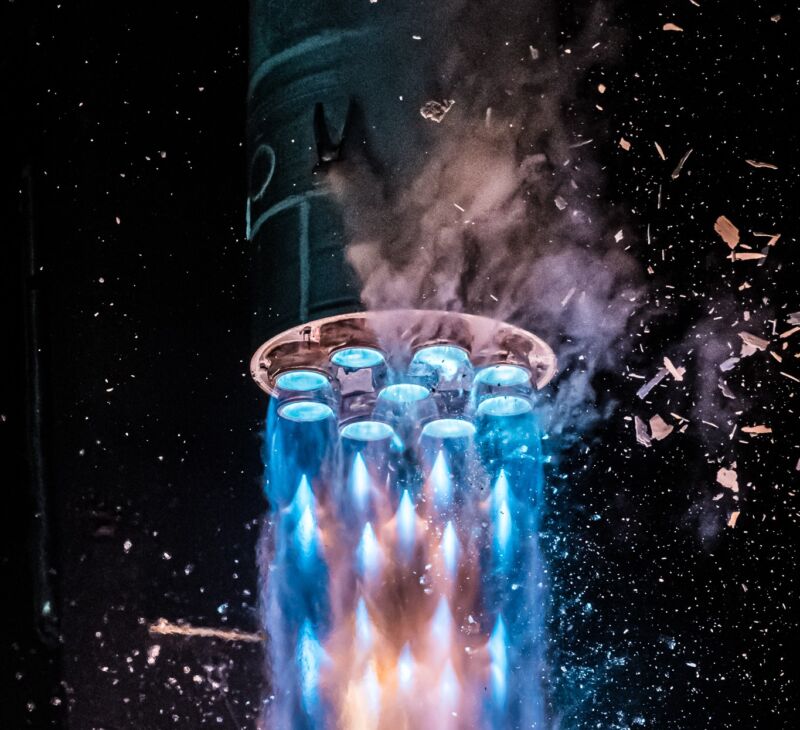
A splashy California-based launch company named Relativity Space shared a photo of sleek-looking rocket hardware on its social media channels last week. The image featured an impressively large payload fairing, which protects satellites on the ride into space.
“Time to take a look at Terran R’s payload envelope,” the company said, calling attention to three people standing to the left of the tall fairing.
Such an anodyne post seems an unlikely candidate to spark an analysis of what is really happening at Relativity Space, but that’s exactly what happened. Less than an hour after its publication, a source I’ve been talking to about Relativity for a while contacted me again.

“So they post a fairing, makes you think they have a fairing, right?” this person said.
A little digging into the photo revealed some interesting details. For example, the exit sign in the background is characteristic of those found in Europe rather than the United States. Soon, it became clear that this photo was taken inside the fairing factory of a company called Beyond Gravity, formerly known as Ruag Space, which is based in Emmen, Switzerland. And at the base of the fairing there is a large, white placard blocking a sign, which apparently discloses that this hardware was built for Europe’s Ariane 6 rocket.
In fact, the only thing that can be confirmed to be related to Relativity Space in this photo is the man at the far left—Drew Hess, senior mission management official at Relativity.
The public release of a photo suggestive of a payload fairing that Relativity built for its Terran R rocket—but which seems to be an Ariane 6 payload fairing manufactured many months ago—is confusing at best. But this was a clarifying moment for me, as the photo’s release validated other information my source had been sharing in recent weeks.
These documents, files, and comments raised a singular question: What the heck is going on at Relativity Space?
A compelling origin story
A pair of talented aerospace engineers, Tim Ellis and Jordan Noone, founded Relativity Space nine years ago with the intent of using 3D printing to manufacture rockets. They left jobs at Blue Origin and SpaceX, believing they could accelerate the commercial launch revolution.
Ellis took the role of chief executive, and he proved to be a prolific fundraiser. By June 2021, the company had raised more than $1.3 billion, and its latest Series E funding round valued the company at $4.2 billion. With this funding in hand, Ellis said Relativity could both execute on its smaller Terran 1 rocket and develop the larger and ambitious Terran R booster to compete with the industry-leading Falcon 9 rocket.
In March 2023, the company launched Terran 1 for the first time. This marked a significant achievement: flying a largely additively manufactured rocket with a novel methane-fueled engine. The first stage flew extremely well—exceeding the performance of most launch startups on their initial flight. However, there was a problem with a liquid oxygen pump during the second stage, and its Aeon engine never achieved full thrust. The rocket was lost.
Despite this considerable success, in the days after this launch, I began to hear talk from various sources that Relativity intended to retire the Terran 1. Additionally, these sources said the company was having difficulty with its 3D printing processes.
In an interview a few weeks after Terran 1’s debut, Ellis acknowledged the Terran 1 was done and that Relativity was pivoting fully to Terran R. He said the market opportunity for Terran R, intended to lift a staggering 33.5 metric tons in fully expendable mode, was too great to pass up. As for 3D printing, Relativity had experienced some growing pains with issues like cracking. The company planned to lean heavily into 3D printing for engines and other parts of the Terran R rocket. But Ellis said he could no longer claim that Terran R would be 90 percent additively manufactured.
And that’s where things remained for more than a year, with Relativity presumably heads down, hard at work on bringing Terran R to the launch pad in 2026. That is, until an insider began sending me documents highlighting Relativity’s struggles to develop the Terran R rocket.
